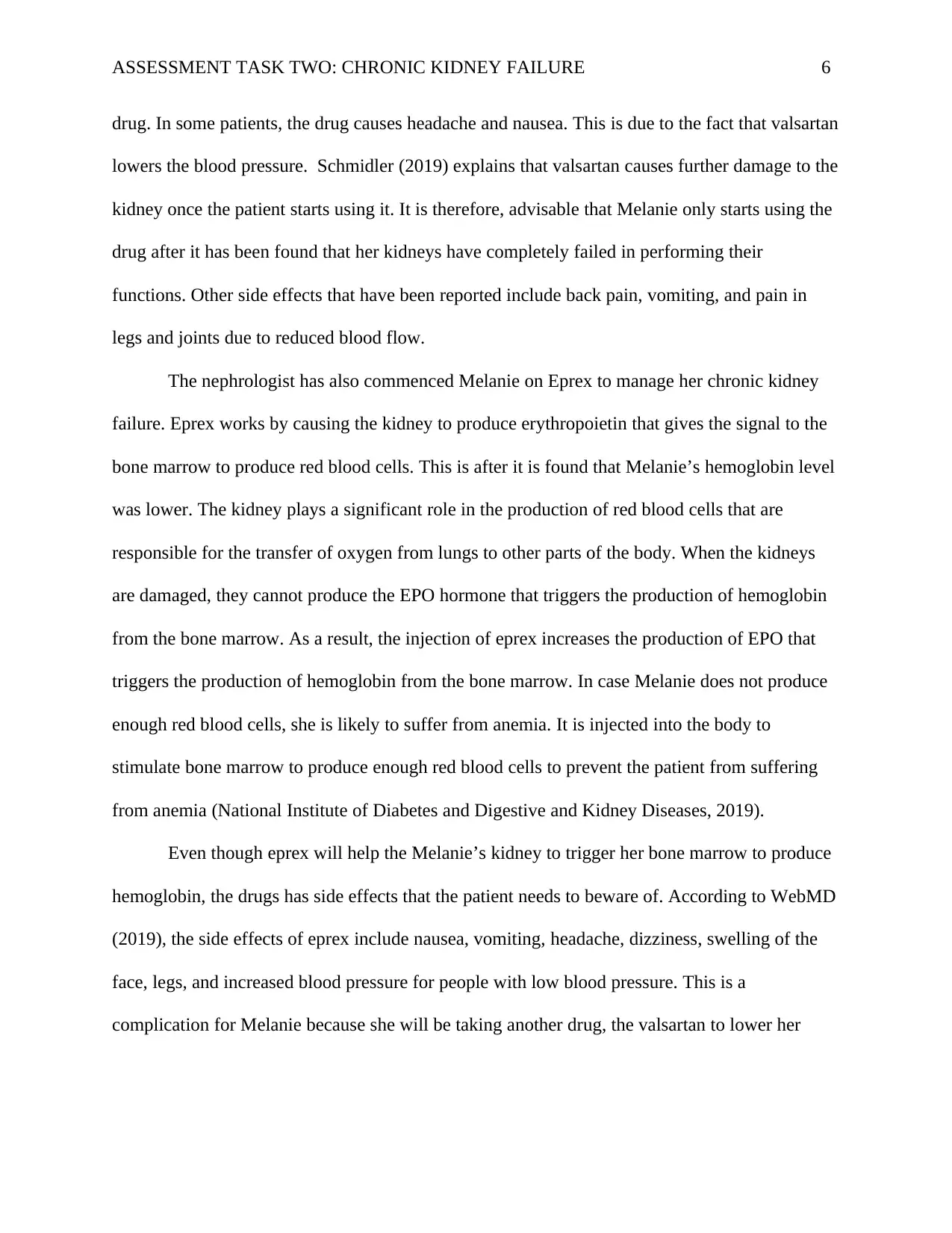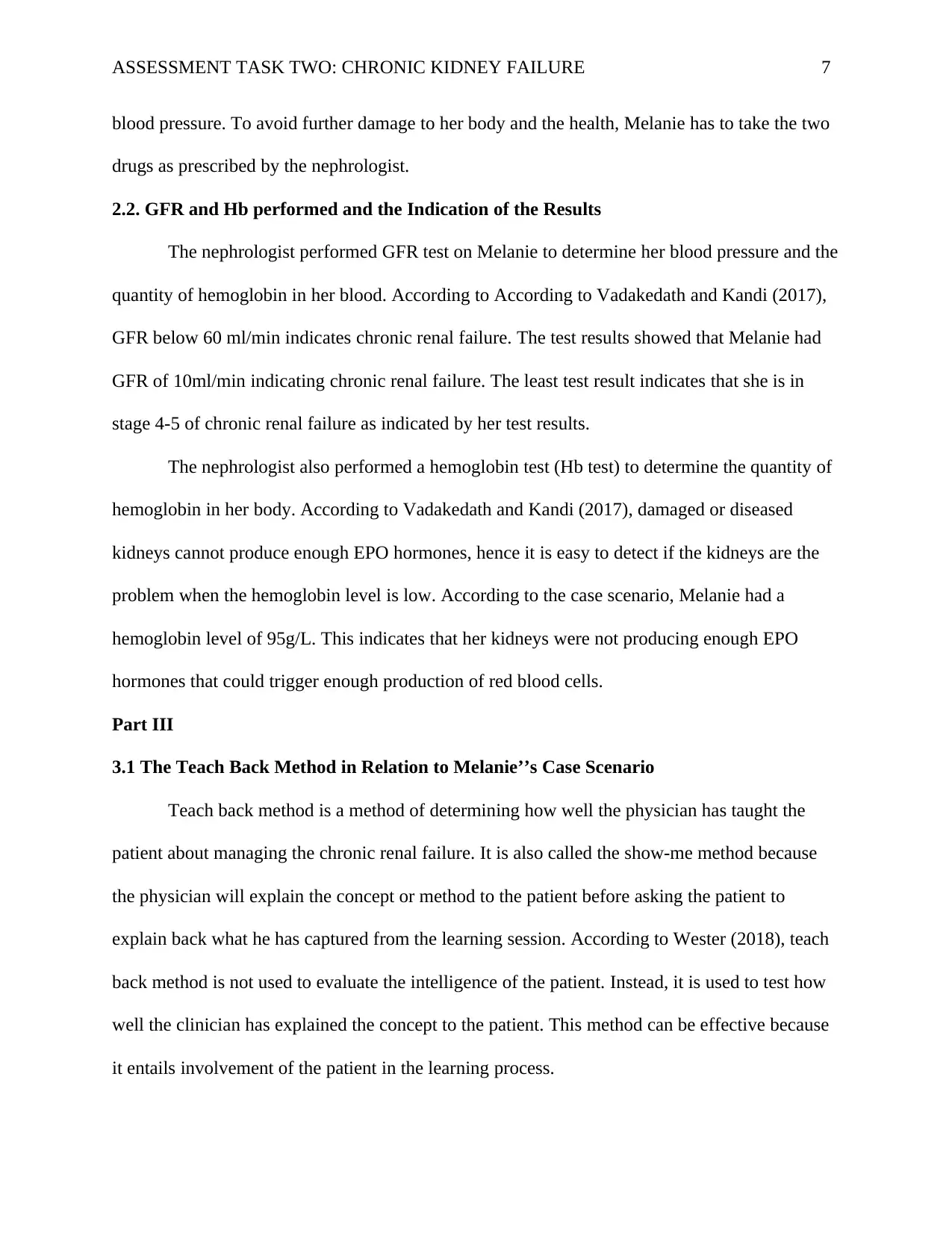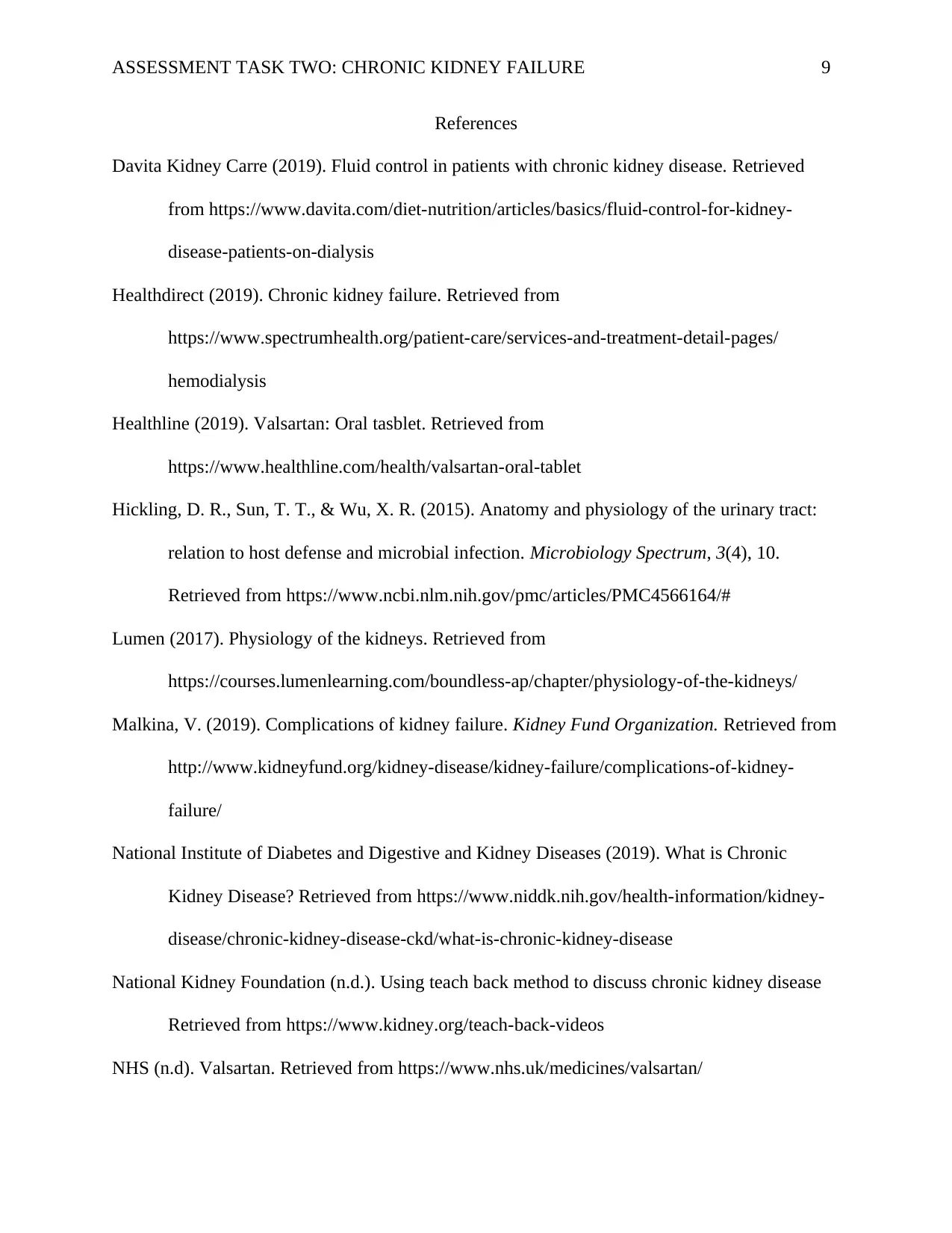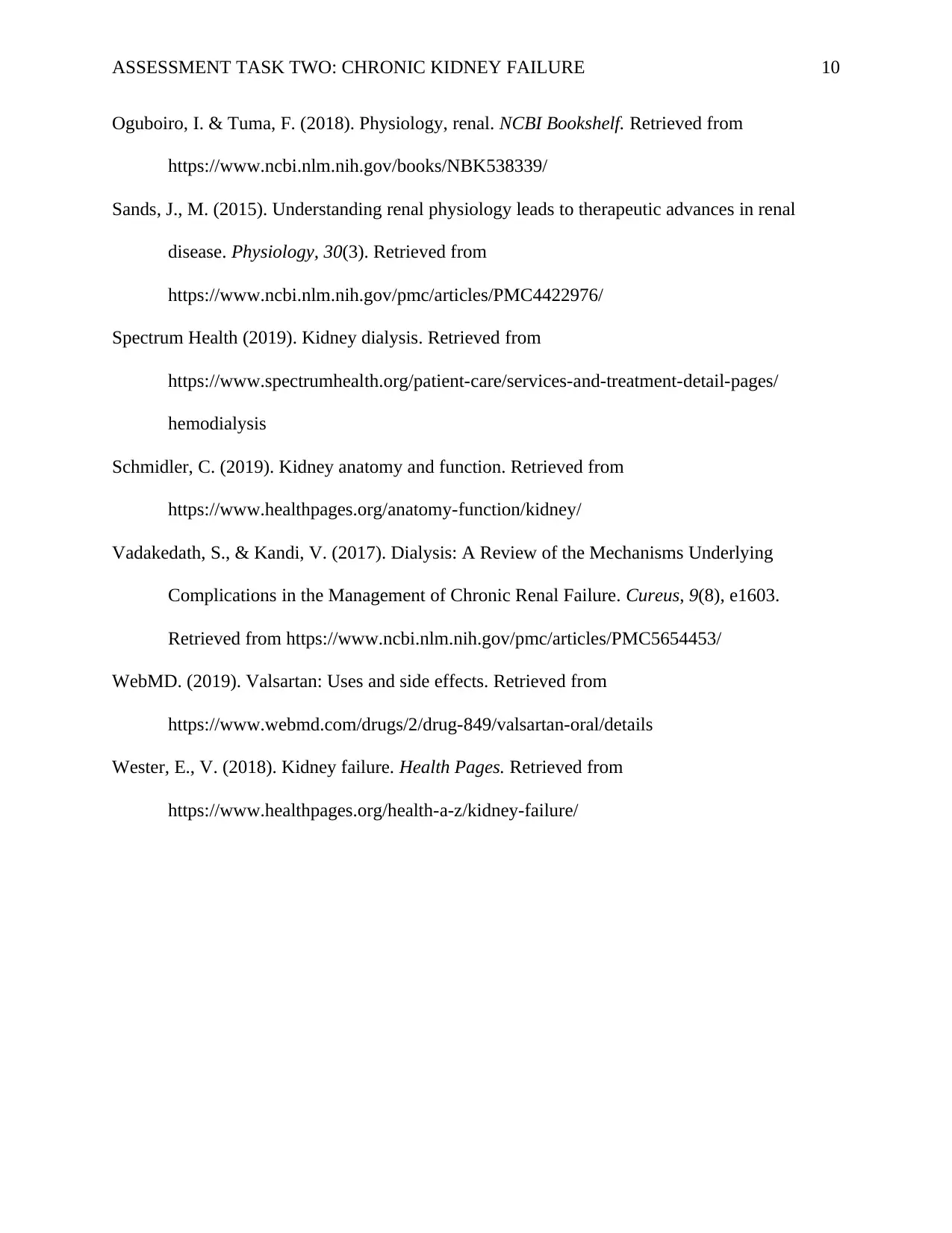Chronic Kidney Failure Assessment Report - NURBN2016
VerifiedAdded on 2022/11/01
|10
|2824
|74
Report
AI Summary
This report provides a comprehensive analysis of chronic kidney failure, examining the renal system's anatomy and physiology, including the kidneys, ureters, and urethra. It delves into the pathophysiology of chronic kidney failure, outlining risk factors such as hypertension, diabetes, and medication use (ibuprofen), and explores treatment options like hemodialysis and kidney transplant. The report details the differences between acute and chronic renal failure, the process of hemodialysis, and discusses the medications valsartan and eprex, including their side effects. It also analyzes GFR and Hb test results and explains the teach-back method in patient education. The case study of Melanie Johnson, a 55-year-old woman, is used to illustrate the concepts and provides a practical application of the information.

Running head: ASSESSMENT TASK TWO: CHRONIC KIDNEY FAILURE
Assessment Task Two: Chronic Kidney Failure
Name
Institutional Affiliation
Assessment Task Two: Chronic Kidney Failure
Name
Institutional Affiliation
Paraphrase This Document
Need a fresh take? Get an instant paraphrase of this document with our AI Paraphraser

ASSESSMENT TASK TWO: CHRONIC KIDNEY FAILURE 2
Assessment Task Two: Chronic Kidney Failure
Part I.
1.1. The Renal anatomy and physiology
The renal system comprises of the kidney, urinary bladder, ureters, and the urethra. The
primary functions of the renal system are to collect wastes from the body and let them out
through the urethra, to maintain fluid pressure in the body, and balance homeostatic processes
(Healthdirect, 2019). Renal anatomy is the general term for the study of the renal system and its
structures. The renal system, also called the renal system comprises of two kidneys whose main
function is to collect wastes carried in blood. Their role is to carry out the purification process of
the blood by removing electrolytes, urea, and other chemical compounds before releasing
purified blood back to the circulatory system. According to the National Kidney Foundation
(n.d.), each kidney is connected to ureters that collect urine and dispose it into the urinary blood
where it is held temporarily before it is released out of the body through the urethra. Purification
of blood takes place mainly in the nephron of the kidney. Hickling, Sun, and W (2015) explain
that each kidney has millions of nephrons that are responsible for removing the wastes from
blood. The two primary processes that take place in the kidney are renal blood flow and
glomerular filtration. These process maintain homeostatic pressure in the body.
1.2. Chronic renal failure, risk factors, complications, and treatment options
Even though the kidney is a vital organ in the renal system, it may undergo structural
changes that may be triggered by diseases to render it ineffective in performing its functions.
These changes mainly occur in nephrons where they are damaged gradually to the extent where
their decrease in number affects their ability to cope with the volume of blood that flows to them
for purification as discussed in Sands (2015). The damage done on nephrons is chronic and
Assessment Task Two: Chronic Kidney Failure
Part I.
1.1. The Renal anatomy and physiology
The renal system comprises of the kidney, urinary bladder, ureters, and the urethra. The
primary functions of the renal system are to collect wastes from the body and let them out
through the urethra, to maintain fluid pressure in the body, and balance homeostatic processes
(Healthdirect, 2019). Renal anatomy is the general term for the study of the renal system and its
structures. The renal system, also called the renal system comprises of two kidneys whose main
function is to collect wastes carried in blood. Their role is to carry out the purification process of
the blood by removing electrolytes, urea, and other chemical compounds before releasing
purified blood back to the circulatory system. According to the National Kidney Foundation
(n.d.), each kidney is connected to ureters that collect urine and dispose it into the urinary blood
where it is held temporarily before it is released out of the body through the urethra. Purification
of blood takes place mainly in the nephron of the kidney. Hickling, Sun, and W (2015) explain
that each kidney has millions of nephrons that are responsible for removing the wastes from
blood. The two primary processes that take place in the kidney are renal blood flow and
glomerular filtration. These process maintain homeostatic pressure in the body.
1.2. Chronic renal failure, risk factors, complications, and treatment options
Even though the kidney is a vital organ in the renal system, it may undergo structural
changes that may be triggered by diseases to render it ineffective in performing its functions.
These changes mainly occur in nephrons where they are damaged gradually to the extent where
their decrease in number affects their ability to cope with the volume of blood that flows to them
for purification as discussed in Sands (2015). The damage done on nephrons is chronic and

ASSESSMENT TASK TWO: CHRONIC KIDNEY FAILURE 3
progressive, even though symptoms appear. Once the number of nephrons damaged has reached
the minimum required number, the kidney becomes unable to perform its function and the person
is said to be suffering from renal failure, also called end stage renal disease (ESRD). ESRD is
irreversible because the kidney has a limited ability to degenerate its cells.
Melanie is in the end stage of renal disease because of the gradual yet progressive
damage done on her kidney. The possible cause of this is either hypertension, diabetes, or too
much use of ibuprofen drugs. According to the case scenario, Melanie has been using ibuprofen
for twelve years each time she feels headache and the pain goes away. The case scenario also
shows that Melanie’s BP is 190/110. This is an indication of high blood pressure. High blood
pressure forces blood into the vital organs like the kidney and the liver. When blood is pumped
into the kidney under pressure, the nephrons are overworked and this can lead to their further
damage if they had already been destroyed. This is the case with Melanie’s condition.
Chronic renal failure cannot be cured, but Melanie has two treatment options to continue
living. The first treatment option is hemodialysis, where her blood is artificially purified by
pumping it through a dialysis machine. According to WebMD (2018), dialysis machines act like
temporary kidneys, but they do not perform all the functions that the active kidney used to
perform. The other treatment option is the kidney transplant, which includes complete removal
of her kidney and transfer of a new kidney from a donor. If Melanie undergoes kidney transplant,
she will not need the artificial dialysis because the new kidney will function like her previous
kidney, even though she needs to stay careful to avoid other complications.
Even though hemodialysis will help Melanie to live longer, there are complications that
may result from the use of this process. According to Davita Kidney Carre (2019), Melanie may
experience complications of anemia, fluid buildup, hypoglycemia, and heart diseases. Anemia is
progressive, even though symptoms appear. Once the number of nephrons damaged has reached
the minimum required number, the kidney becomes unable to perform its function and the person
is said to be suffering from renal failure, also called end stage renal disease (ESRD). ESRD is
irreversible because the kidney has a limited ability to degenerate its cells.
Melanie is in the end stage of renal disease because of the gradual yet progressive
damage done on her kidney. The possible cause of this is either hypertension, diabetes, or too
much use of ibuprofen drugs. According to the case scenario, Melanie has been using ibuprofen
for twelve years each time she feels headache and the pain goes away. The case scenario also
shows that Melanie’s BP is 190/110. This is an indication of high blood pressure. High blood
pressure forces blood into the vital organs like the kidney and the liver. When blood is pumped
into the kidney under pressure, the nephrons are overworked and this can lead to their further
damage if they had already been destroyed. This is the case with Melanie’s condition.
Chronic renal failure cannot be cured, but Melanie has two treatment options to continue
living. The first treatment option is hemodialysis, where her blood is artificially purified by
pumping it through a dialysis machine. According to WebMD (2018), dialysis machines act like
temporary kidneys, but they do not perform all the functions that the active kidney used to
perform. The other treatment option is the kidney transplant, which includes complete removal
of her kidney and transfer of a new kidney from a donor. If Melanie undergoes kidney transplant,
she will not need the artificial dialysis because the new kidney will function like her previous
kidney, even though she needs to stay careful to avoid other complications.
Even though hemodialysis will help Melanie to live longer, there are complications that
may result from the use of this process. According to Davita Kidney Carre (2019), Melanie may
experience complications of anemia, fluid buildup, hypoglycemia, and heart diseases. Anemia is
⊘ This is a preview!⊘
Do you want full access?
Subscribe today to unlock all pages.

Trusted by 1+ million students worldwide

ASSESSMENT TASK TWO: CHRONIC KIDNEY FAILURE 4
caused by insufficient production of red blood cells. If Melanie’s kidneys have failed, they will
not be able to produce sufficient hormone called EPO that is responsible for triggering
production of red blood cells from bone marrow (Malkina, 2019). Fluid buildup is a result of the
kidney to filter blood to remove wastes and release purified blood back to the blood stream.
Fluid buildup has adverse effects to the body because it affects other parts of the body such as
the liver and the heart. Melanie may experience swelling in legs and lower abdomen, increased
heartbeat, and headache as the heart struggles to get rid of the fluid.
1.3. Differences between acute and chronic renal failure
There are significant differences between acute kidney disease (AKD) and chronic kidney
disease (CKD)/chronic renal failure, even though both are diseases of the kidney. AKD is
sudden, while CKD is gradual and progressive to the point where the kidneys cannot function.
AKD can be cured after medications, but CKD cannot be cured because the damage is
permanent. A patient with AKD does not require kidney transplant or hemodialysis, but patients
with CKD require hemodialysis or kidney transplant because the kidneys cannot perform their
functions. AKD does not lead to further complications such as anemia, but CKD may lead to
anemia because of failure of the kidney (Oguboiro and Tuma (2018). AKD results from physical
injury and damage to the kidney, but CKD results from conditions such as hypertension and
diabetes
1.4. Renal replacement therapy (Hemodialysis)
Hemodialysis is a chronic kidney failure therapy performed using dialysis machines. It is
artificial method of removing wastes and chemical compounds from blood to enable the body to
function properly. According to the National Institute of Diabetes and Digestive and Kidney
Diseases (2019), the blood is purified by pumping it through filters in the dialysis machine
caused by insufficient production of red blood cells. If Melanie’s kidneys have failed, they will
not be able to produce sufficient hormone called EPO that is responsible for triggering
production of red blood cells from bone marrow (Malkina, 2019). Fluid buildup is a result of the
kidney to filter blood to remove wastes and release purified blood back to the blood stream.
Fluid buildup has adverse effects to the body because it affects other parts of the body such as
the liver and the heart. Melanie may experience swelling in legs and lower abdomen, increased
heartbeat, and headache as the heart struggles to get rid of the fluid.
1.3. Differences between acute and chronic renal failure
There are significant differences between acute kidney disease (AKD) and chronic kidney
disease (CKD)/chronic renal failure, even though both are diseases of the kidney. AKD is
sudden, while CKD is gradual and progressive to the point where the kidneys cannot function.
AKD can be cured after medications, but CKD cannot be cured because the damage is
permanent. A patient with AKD does not require kidney transplant or hemodialysis, but patients
with CKD require hemodialysis or kidney transplant because the kidneys cannot perform their
functions. AKD does not lead to further complications such as anemia, but CKD may lead to
anemia because of failure of the kidney (Oguboiro and Tuma (2018). AKD results from physical
injury and damage to the kidney, but CKD results from conditions such as hypertension and
diabetes
1.4. Renal replacement therapy (Hemodialysis)
Hemodialysis is a chronic kidney failure therapy performed using dialysis machines. It is
artificial method of removing wastes and chemical compounds from blood to enable the body to
function properly. According to the National Institute of Diabetes and Digestive and Kidney
Diseases (2019), the blood is purified by pumping it through filters in the dialysis machine
Paraphrase This Document
Need a fresh take? Get an instant paraphrase of this document with our AI Paraphraser

ASSESSMENT TASK TWO: CHRONIC KIDNEY FAILURE 5
before it is pumped back to the body. During the process, chemical wastes are artificially
removed from the blood in the same way the nephrons in the kidney work.
If Melanie undergoes hemodialysis, she will need to make an arrangement with a
nephrologist to see learn how she will manage the disease. Even though hemodialysis will help
Melanie to live longer, she has to beware of the side effects associated with this therapy. The
process will take away her independence and she may experience other complications such as
nausea, swelling in legs, and fluid shifts because the process relies on artificial processes. To
avoid the severity of complications, Melanie should limit fluid intake as this will reduce the need
for frequent purification of her blood. There will also be a need for diet management to limit
buildup of urea and chemical compounds in her blood.
Part II
2.1. Discussion of medications and their side effects
The nephrologist has commenced Melanie to two medications after performing the blood
test. The valsartan 80 mg is to lower Melanie’s blood pressure. According to the test results
performed on Melanie, she had a BP of 190/110. There is a need to lower Melanie’s blood
pressure because high blood pressure is causes adverse effects on the kidney because it can make
the blood vessels to burst when they are forced to carry high volumes of blood. According to
NHS (n.d.), valsartan 80 mg is prescribed for patients with low blood pressure. Valsartan relaxes
the blood vessels by increasing the volume of blood they carry, hence lowering the blood
pressure.
Even though valsartan will help in managing Melanie’s chronic kidney failure, the drug
has been linked to some side effects that may affect the quality of life in the patient. According
to Healthdirect (2019), some patients have reported experiencing dizziness after using valsartan
before it is pumped back to the body. During the process, chemical wastes are artificially
removed from the blood in the same way the nephrons in the kidney work.
If Melanie undergoes hemodialysis, she will need to make an arrangement with a
nephrologist to see learn how she will manage the disease. Even though hemodialysis will help
Melanie to live longer, she has to beware of the side effects associated with this therapy. The
process will take away her independence and she may experience other complications such as
nausea, swelling in legs, and fluid shifts because the process relies on artificial processes. To
avoid the severity of complications, Melanie should limit fluid intake as this will reduce the need
for frequent purification of her blood. There will also be a need for diet management to limit
buildup of urea and chemical compounds in her blood.
Part II
2.1. Discussion of medications and their side effects
The nephrologist has commenced Melanie to two medications after performing the blood
test. The valsartan 80 mg is to lower Melanie’s blood pressure. According to the test results
performed on Melanie, she had a BP of 190/110. There is a need to lower Melanie’s blood
pressure because high blood pressure is causes adverse effects on the kidney because it can make
the blood vessels to burst when they are forced to carry high volumes of blood. According to
NHS (n.d.), valsartan 80 mg is prescribed for patients with low blood pressure. Valsartan relaxes
the blood vessels by increasing the volume of blood they carry, hence lowering the blood
pressure.
Even though valsartan will help in managing Melanie’s chronic kidney failure, the drug
has been linked to some side effects that may affect the quality of life in the patient. According
to Healthdirect (2019), some patients have reported experiencing dizziness after using valsartan

ASSESSMENT TASK TWO: CHRONIC KIDNEY FAILURE 6
drug. In some patients, the drug causes headache and nausea. This is due to the fact that valsartan
lowers the blood pressure. Schmidler (2019) explains that valsartan causes further damage to the
kidney once the patient starts using it. It is therefore, advisable that Melanie only starts using the
drug after it has been found that her kidneys have completely failed in performing their
functions. Other side effects that have been reported include back pain, vomiting, and pain in
legs and joints due to reduced blood flow.
The nephrologist has also commenced Melanie on Eprex to manage her chronic kidney
failure. Eprex works by causing the kidney to produce erythropoietin that gives the signal to the
bone marrow to produce red blood cells. This is after it is found that Melanie’s hemoglobin level
was lower. The kidney plays a significant role in the production of red blood cells that are
responsible for the transfer of oxygen from lungs to other parts of the body. When the kidneys
are damaged, they cannot produce the EPO hormone that triggers the production of hemoglobin
from the bone marrow. As a result, the injection of eprex increases the production of EPO that
triggers the production of hemoglobin from the bone marrow. In case Melanie does not produce
enough red blood cells, she is likely to suffer from anemia. It is injected into the body to
stimulate bone marrow to produce enough red blood cells to prevent the patient from suffering
from anemia (National Institute of Diabetes and Digestive and Kidney Diseases, 2019).
Even though eprex will help the Melanie’s kidney to trigger her bone marrow to produce
hemoglobin, the drugs has side effects that the patient needs to beware of. According to WebMD
(2019), the side effects of eprex include nausea, vomiting, headache, dizziness, swelling of the
face, legs, and increased blood pressure for people with low blood pressure. This is a
complication for Melanie because she will be taking another drug, the valsartan to lower her
drug. In some patients, the drug causes headache and nausea. This is due to the fact that valsartan
lowers the blood pressure. Schmidler (2019) explains that valsartan causes further damage to the
kidney once the patient starts using it. It is therefore, advisable that Melanie only starts using the
drug after it has been found that her kidneys have completely failed in performing their
functions. Other side effects that have been reported include back pain, vomiting, and pain in
legs and joints due to reduced blood flow.
The nephrologist has also commenced Melanie on Eprex to manage her chronic kidney
failure. Eprex works by causing the kidney to produce erythropoietin that gives the signal to the
bone marrow to produce red blood cells. This is after it is found that Melanie’s hemoglobin level
was lower. The kidney plays a significant role in the production of red blood cells that are
responsible for the transfer of oxygen from lungs to other parts of the body. When the kidneys
are damaged, they cannot produce the EPO hormone that triggers the production of hemoglobin
from the bone marrow. As a result, the injection of eprex increases the production of EPO that
triggers the production of hemoglobin from the bone marrow. In case Melanie does not produce
enough red blood cells, she is likely to suffer from anemia. It is injected into the body to
stimulate bone marrow to produce enough red blood cells to prevent the patient from suffering
from anemia (National Institute of Diabetes and Digestive and Kidney Diseases, 2019).
Even though eprex will help the Melanie’s kidney to trigger her bone marrow to produce
hemoglobin, the drugs has side effects that the patient needs to beware of. According to WebMD
(2019), the side effects of eprex include nausea, vomiting, headache, dizziness, swelling of the
face, legs, and increased blood pressure for people with low blood pressure. This is a
complication for Melanie because she will be taking another drug, the valsartan to lower her
⊘ This is a preview!⊘
Do you want full access?
Subscribe today to unlock all pages.

Trusted by 1+ million students worldwide

ASSESSMENT TASK TWO: CHRONIC KIDNEY FAILURE 7
blood pressure. To avoid further damage to her body and the health, Melanie has to take the two
drugs as prescribed by the nephrologist.
2.2. GFR and Hb performed and the Indication of the Results
The nephrologist performed GFR test on Melanie to determine her blood pressure and the
quantity of hemoglobin in her blood. According to According to Vadakedath and Kandi (2017),
GFR below 60 ml/min indicates chronic renal failure. The test results showed that Melanie had
GFR of 10ml/min indicating chronic renal failure. The least test result indicates that she is in
stage 4-5 of chronic renal failure as indicated by her test results.
The nephrologist also performed a hemoglobin test (Hb test) to determine the quantity of
hemoglobin in her body. According to Vadakedath and Kandi (2017), damaged or diseased
kidneys cannot produce enough EPO hormones, hence it is easy to detect if the kidneys are the
problem when the hemoglobin level is low. According to the case scenario, Melanie had a
hemoglobin level of 95g/L. This indicates that her kidneys were not producing enough EPO
hormones that could trigger enough production of red blood cells.
Part III
3.1 The Teach Back Method in Relation to Melanie’’s Case Scenario
Teach back method is a method of determining how well the physician has taught the
patient about managing the chronic renal failure. It is also called the show-me method because
the physician will explain the concept or method to the patient before asking the patient to
explain back what he has captured from the learning session. According to Wester (2018), teach
back method is not used to evaluate the intelligence of the patient. Instead, it is used to test how
well the clinician has explained the concept to the patient. This method can be effective because
it entails involvement of the patient in the learning process.
blood pressure. To avoid further damage to her body and the health, Melanie has to take the two
drugs as prescribed by the nephrologist.
2.2. GFR and Hb performed and the Indication of the Results
The nephrologist performed GFR test on Melanie to determine her blood pressure and the
quantity of hemoglobin in her blood. According to According to Vadakedath and Kandi (2017),
GFR below 60 ml/min indicates chronic renal failure. The test results showed that Melanie had
GFR of 10ml/min indicating chronic renal failure. The least test result indicates that she is in
stage 4-5 of chronic renal failure as indicated by her test results.
The nephrologist also performed a hemoglobin test (Hb test) to determine the quantity of
hemoglobin in her body. According to Vadakedath and Kandi (2017), damaged or diseased
kidneys cannot produce enough EPO hormones, hence it is easy to detect if the kidneys are the
problem when the hemoglobin level is low. According to the case scenario, Melanie had a
hemoglobin level of 95g/L. This indicates that her kidneys were not producing enough EPO
hormones that could trigger enough production of red blood cells.
Part III
3.1 The Teach Back Method in Relation to Melanie’’s Case Scenario
Teach back method is a method of determining how well the physician has taught the
patient about managing the chronic renal failure. It is also called the show-me method because
the physician will explain the concept or method to the patient before asking the patient to
explain back what he has captured from the learning session. According to Wester (2018), teach
back method is not used to evaluate the intelligence of the patient. Instead, it is used to test how
well the clinician has explained the concept to the patient. This method can be effective because
it entails involvement of the patient in the learning process.
Paraphrase This Document
Need a fresh take? Get an instant paraphrase of this document with our AI Paraphraser

ASSESSMENT TASK TWO: CHRONIC KIDNEY FAILURE 8
Patient education on managing chronic renal failure (teach back method)
Teach back method will be effective in managing Melanie’s condition because I will use
direct involvement of the patient in her own care. When using this method, I will first explain to
Melanie about her condition through demonstrations on how her kidney functions and how
hemodialysis is going to affect its functioning. I will explain how different food intakes that
contain high salts will affect her when she undergoes hemodialysis and how her body will
respond when she takes a lot of water when her kidney has failed. I will even demonstrate to her
how it is necessary for her to limit fluid intakes. Once she has mastered how the hemodialysis
works and how she fluid intake is to be managed, I will ask give her some notes to go through if
she is literate. This will happen with her consent.
Once Melanie has mastered what I have taught her about the condition, I will use the
teach-back method to make her play the role of a teacher. I will ask her to explain to me some of
the ways that can be used to limit fluid intake. Additionally, I will ask to mention some of the
fluid intakes that she is supposed to avoid or limit intake, considering that I did not mention the
type of fluids to be avoided. This approach will be essentially important to Melanie’s case
scenario because it will make her to think critically about her own care in absence of my help,
hence improving on self-management.
Patient education on managing chronic renal failure (teach back method)
Teach back method will be effective in managing Melanie’s condition because I will use
direct involvement of the patient in her own care. When using this method, I will first explain to
Melanie about her condition through demonstrations on how her kidney functions and how
hemodialysis is going to affect its functioning. I will explain how different food intakes that
contain high salts will affect her when she undergoes hemodialysis and how her body will
respond when she takes a lot of water when her kidney has failed. I will even demonstrate to her
how it is necessary for her to limit fluid intakes. Once she has mastered how the hemodialysis
works and how she fluid intake is to be managed, I will ask give her some notes to go through if
she is literate. This will happen with her consent.
Once Melanie has mastered what I have taught her about the condition, I will use the
teach-back method to make her play the role of a teacher. I will ask her to explain to me some of
the ways that can be used to limit fluid intake. Additionally, I will ask to mention some of the
fluid intakes that she is supposed to avoid or limit intake, considering that I did not mention the
type of fluids to be avoided. This approach will be essentially important to Melanie’s case
scenario because it will make her to think critically about her own care in absence of my help,
hence improving on self-management.

ASSESSMENT TASK TWO: CHRONIC KIDNEY FAILURE 9
References
Davita Kidney Carre (2019). Fluid control in patients with chronic kidney disease. Retrieved
from https://www.davita.com/diet-nutrition/articles/basics/fluid-control-for-kidney-
disease-patients-on-dialysis
Healthdirect (2019). Chronic kidney failure. Retrieved from
https://www.spectrumhealth.org/patient-care/services-and-treatment-detail-pages/
hemodialysis
Healthline (2019). Valsartan: Oral tasblet. Retrieved from
https://www.healthline.com/health/valsartan-oral-tablet
Hickling, D. R., Sun, T. T., & Wu, X. R. (2015). Anatomy and physiology of the urinary tract:
relation to host defense and microbial infection. Microbiology Spectrum, 3(4), 10.
Retrieved from https://www.ncbi.nlm.nih.gov/pmc/articles/PMC4566164/#
Lumen (2017). Physiology of the kidneys. Retrieved from
https://courses.lumenlearning.com/boundless-ap/chapter/physiology-of-the-kidneys/
Malkina, V. (2019). Complications of kidney failure. Kidney Fund Organization. Retrieved from
http://www.kidneyfund.org/kidney-disease/kidney-failure/complications-of-kidney-
failure/
National Institute of Diabetes and Digestive and Kidney Diseases (2019). What is Chronic
Kidney Disease? Retrieved from https://www.niddk.nih.gov/health-information/kidney-
disease/chronic-kidney-disease-ckd/what-is-chronic-kidney-disease
National Kidney Foundation (n.d.). Using teach back method to discuss chronic kidney disease
Retrieved from https://www.kidney.org/teach-back-videos
NHS (n.d). Valsartan. Retrieved from https://www.nhs.uk/medicines/valsartan/
References
Davita Kidney Carre (2019). Fluid control in patients with chronic kidney disease. Retrieved
from https://www.davita.com/diet-nutrition/articles/basics/fluid-control-for-kidney-
disease-patients-on-dialysis
Healthdirect (2019). Chronic kidney failure. Retrieved from
https://www.spectrumhealth.org/patient-care/services-and-treatment-detail-pages/
hemodialysis
Healthline (2019). Valsartan: Oral tasblet. Retrieved from
https://www.healthline.com/health/valsartan-oral-tablet
Hickling, D. R., Sun, T. T., & Wu, X. R. (2015). Anatomy and physiology of the urinary tract:
relation to host defense and microbial infection. Microbiology Spectrum, 3(4), 10.
Retrieved from https://www.ncbi.nlm.nih.gov/pmc/articles/PMC4566164/#
Lumen (2017). Physiology of the kidneys. Retrieved from
https://courses.lumenlearning.com/boundless-ap/chapter/physiology-of-the-kidneys/
Malkina, V. (2019). Complications of kidney failure. Kidney Fund Organization. Retrieved from
http://www.kidneyfund.org/kidney-disease/kidney-failure/complications-of-kidney-
failure/
National Institute of Diabetes and Digestive and Kidney Diseases (2019). What is Chronic
Kidney Disease? Retrieved from https://www.niddk.nih.gov/health-information/kidney-
disease/chronic-kidney-disease-ckd/what-is-chronic-kidney-disease
National Kidney Foundation (n.d.). Using teach back method to discuss chronic kidney disease
Retrieved from https://www.kidney.org/teach-back-videos
NHS (n.d). Valsartan. Retrieved from https://www.nhs.uk/medicines/valsartan/
⊘ This is a preview!⊘
Do you want full access?
Subscribe today to unlock all pages.

Trusted by 1+ million students worldwide

ASSESSMENT TASK TWO: CHRONIC KIDNEY FAILURE 10
Oguboiro, I. & Tuma, F. (2018). Physiology, renal. NCBI Bookshelf. Retrieved from
https://www.ncbi.nlm.nih.gov/books/NBK538339/
Sands, J., M. (2015). Understanding renal physiology leads to therapeutic advances in renal
disease. Physiology, 30(3). Retrieved from
https://www.ncbi.nlm.nih.gov/pmc/articles/PMC4422976/
Spectrum Health (2019). Kidney dialysis. Retrieved from
https://www.spectrumhealth.org/patient-care/services-and-treatment-detail-pages/
hemodialysis
Schmidler, C. (2019). Kidney anatomy and function. Retrieved from
https://www.healthpages.org/anatomy-function/kidney/
Vadakedath, S., & Kandi, V. (2017). Dialysis: A Review of the Mechanisms Underlying
Complications in the Management of Chronic Renal Failure. Cureus, 9(8), e1603.
Retrieved from https://www.ncbi.nlm.nih.gov/pmc/articles/PMC5654453/
WebMD. (2019). Valsartan: Uses and side effects. Retrieved from
https://www.webmd.com/drugs/2/drug-849/valsartan-oral/details
Wester, E., V. (2018). Kidney failure. Health Pages. Retrieved from
https://www.healthpages.org/health-a-z/kidney-failure/
Oguboiro, I. & Tuma, F. (2018). Physiology, renal. NCBI Bookshelf. Retrieved from
https://www.ncbi.nlm.nih.gov/books/NBK538339/
Sands, J., M. (2015). Understanding renal physiology leads to therapeutic advances in renal
disease. Physiology, 30(3). Retrieved from
https://www.ncbi.nlm.nih.gov/pmc/articles/PMC4422976/
Spectrum Health (2019). Kidney dialysis. Retrieved from
https://www.spectrumhealth.org/patient-care/services-and-treatment-detail-pages/
hemodialysis
Schmidler, C. (2019). Kidney anatomy and function. Retrieved from
https://www.healthpages.org/anatomy-function/kidney/
Vadakedath, S., & Kandi, V. (2017). Dialysis: A Review of the Mechanisms Underlying
Complications in the Management of Chronic Renal Failure. Cureus, 9(8), e1603.
Retrieved from https://www.ncbi.nlm.nih.gov/pmc/articles/PMC5654453/
WebMD. (2019). Valsartan: Uses and side effects. Retrieved from
https://www.webmd.com/drugs/2/drug-849/valsartan-oral/details
Wester, E., V. (2018). Kidney failure. Health Pages. Retrieved from
https://www.healthpages.org/health-a-z/kidney-failure/
1 out of 10
Related Documents
Your All-in-One AI-Powered Toolkit for Academic Success.
+13062052269
info@desklib.com
Available 24*7 on WhatsApp / Email
![[object Object]](/_next/static/media/star-bottom.7253800d.svg)
Unlock your academic potential
Copyright © 2020–2025 A2Z Services. All Rights Reserved. Developed and managed by ZUCOL.





